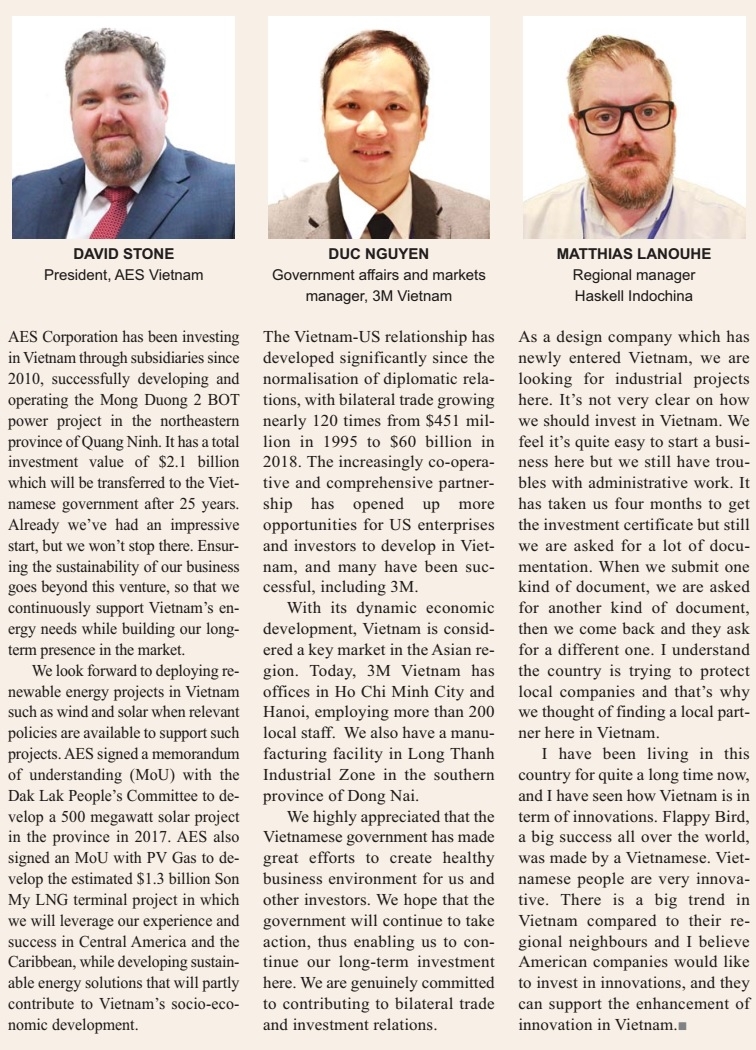Spurring US investment into new phase
 |
| Spurring US investment into new phase, illustration photo |
The American Chamber of Commerce in Hanoi (AmCham), the US Chamber of Commerce, and the Vietnam Chamber of Commerce and Industry last week hosted the annual Vietnam-US Business Summit, attracting 250 government and industry leaders from both countries, including leading American firms like Amazon, Coca-Cola, and Facebook.
The event was created to build on current the momentum of bilateral economic relations and to
address the areas where inconsistencies, inefficiencies, and unfair practices persist.
“American companies have invested billions of dollars here, integrating Vietnam into the global supply chain, creating quality jobs for Vietnamese workers, and opening a new market for US goods and services,” said Amcham chairwoman Natasha Ansell. “American companies have an interest in Vietnam’s continued success and AmCham continues to support the government’s efforts to grow the private sector here.”
During the event, participants focused on the top issues of enhancing the digital economy, addressing energy development needs, promoting a creative economy, and looking at global trade dynamics and competitiveness, all of which are important to Vietnam’s economic development.
The two sides also looked into methods to further enhance bilateral relations to create both long-term economic and social values.
At the event, the US Chamber of Commerce recommended launching an initiative to intensify commercial engagement under the auspices of the existing Trade and Investment Framework Agreement (TIFA). Under the initiative, the two nations would elevate the level of TIFA discussions to more senior officials, with Vietnam’s Government Office and the United States Trade Representative being recommended.
The chamber released a blueprint that outlines a series of recommendations for enhancing the commercial relationship. It called for intensifying work under the existing TIFA between the two countries, with specific agreements in areas such as digital trade, customs and trade facilitation, energy infrastructure, intellectual property rights, and technical barriers to trade.
To achieve the goals, the chamber suggested that the two sides initiate discussions and conclude agreements on specific initiatives in time for Party General Secretary, State President Nguyen Phu Trong’s expected visit to Washington later this year, or on the margins of the Asia-Pacific Economic Cooperation meeting in Chile or another convenient venue. Following signature, the two sides should immediately begin work on the various initiatives, with the first meeting under the intensified TIFA to be held in spring 2020, and a second meeting to be held in the fall surrounding the APEC meeting in Malaysia.
Experts hope that once the blueprint is completed, bilateral trade and investment ties will enter a new chapter of development.
Economic relations between Vietnam and the US have grown exponentially since the two countries restored diplomatic ties 25 years ago. Since 2003, the US has always been among Vietnam’s largest export markets, while Vietnam has consistently been among the US’ export markets with the fastest growth. Last year, US exports to Vietnam rose by 46 per cent on-year.
In terms of funding, US investment has continued to increase. As of last month, the US invested over $9 billion in Vietnam, ranking 11th among all countries and territories having investment here.
“Our members are very focused on Vietnam, and are optimistic about the potential for growth in this market,” said Charles Freeman, senior vice president for Asia at the US Chamber of Commerce.
“We continue to believe that the long-term goal for the US and Vietnam should be to have a free trade agreement between them. At the same time, we recognise the nearer-term realities and we have therefore outlined a series of steps which we believe are practical, achievable, and realistic. These will facilitate greater trade and investment, and form the building blocks of an eventual agreement.”
Evidently, American investors are ready for new plans in Vietnam and now look for barriers to be broken and paths to be smoothed out in order to make bold next steps. US investors are heading to Southeast Asia with new policies to shore up markets amidst the trade dispute between China and the US, and to benefit from the American government’s recent announcement of the US-ASEAN Smart Cities partnership.
The move is aligned with Vietnam’s new foreign direct investment attraction strategy towards 2030 and shows its ambition to lure large-scale projects from US investors that have strong expertise in the precise fields the country requires investment in, such as technology, renewable energy, healthcare, and pharmaceuticals. These include transnational corporations named in the Forbes Global 2000 list.
“The relationship between Vietnam and the US has been enhanced over the past 25 years,” said Vietnamese Deputy Prime Minister Trinh Dinh Dung. “Vietnam wants to further strengthen ties with the US, with trade and investment being one of the key pillars. Vietnam encourages American investment, especially in the fields the US has strong expertise, for example renewable energy, infrastructure, banking and finance, education, and high technology.”
 |
What the stars mean:
★ Poor ★ ★ Promising ★★★ Good ★★★★ Very good ★★★★★ Exceptional
 Tag:
Tag:
Related Contents
Latest News
More News
- VIR workshop highlights capital and policy for sustainable development (December 15, 2025 | 11:00)
- National Assembly approves pilot mechanisms to accelerate major projects in Hanoi (December 12, 2025 | 11:29)
- Vietnam eases policy approval requirements, simplifies foreign and outbound investments (December 11, 2025 | 17:53)
- Unpacking new momentum in Vietnam’s M&A market (December 10, 2025 | 09:59)
- Forum honours outstanding M&A deals, strategies, and advisory firms (December 09, 2025 | 18:22)
- Vietnam enters defining phase of M&A growth (December 09, 2025 | 17:00)
- Vietnam’s M&A market opens new opportunities amid strong economic momentum (December 09, 2025 | 15:00)
- Vietnam M&A Forum 2025: new position, new momentum (December 09, 2025 | 14:30)
- FDI in Vietnam jumps on additional capital and share purchases (December 09, 2025 | 13:56)
- VIR gathers dealmakers for M&A forum (December 08, 2025 | 17:17)
























 Mobile Version
Mobile Version